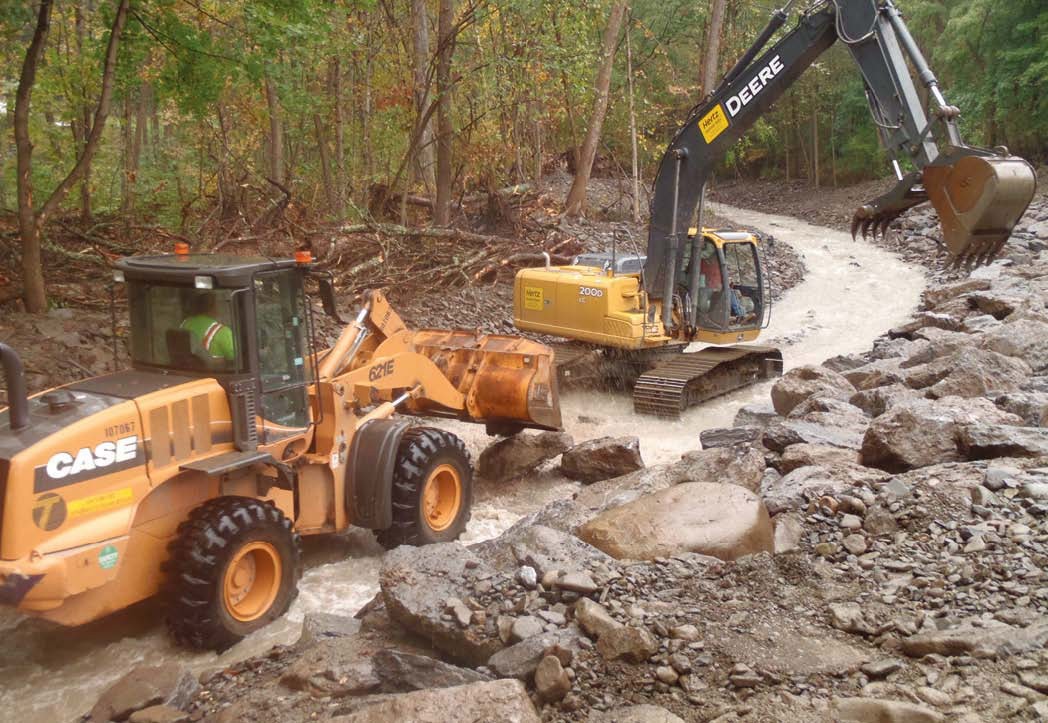After a high-water event, there are people who will say that the way to prevent future flooding is to dig out the river channel so it can hold more water and armor plate the banks with riprap. That approach sometimes works, and in some immediate stretches of river it may be necessary. But a broader view must be considered, as the dig-deeper-and-use-riprap approach can cause property damage downstream during the next flood, and in most cases, it is damaging to the health of a river.
In the past 50 years, we’ve learned a lot about the science of rivers. We’ve learned that rivers are a balanced natural system controlled by the laws of nature and they behave as they do because of the well-understood principles of gravity, force, energy, and friction. Those principles control the hydrological behavior of a river; a river has no choice in the matter. The laws of nature are in charge and they cannot be repealed.
Encroaching physically on our rivers interferes with their natural dynamics and changes how they weather a flood. We cause rivers to rise faster when we construct impermeable surfaces. Human alterations, such as straightening a river, filling wetlands, removing gravel, creating pinch points at undersized bridges and culverts, removing the natural plants from riparian zones and replacing them with riprap, and shutting off a river from its floodplain with berms, roadways, and train tracks, increase the power of rivers, and contribute to floods that destroy property and infrastructure.
We will not stop flooding by making the riprap stone larger, removing more of or even all of the gravel, constructing higher berms, or making rivers arrow-straight from source to confluence with a larger body of water. The laws of nature will not allow those approaches to be successful.
What will lessen flooding damage is allowing rivers to access their floodplains and wetlands where the river water can spread out and slow down; allowing riparian zones to flourish on the banks of rivers; allowing rivers to meander so the meanders can absorb the force of flood flows; allowing rivers to naturally deposit gravel where gravity pulls it out of the water column to achieve river stability (as rivers have done for millennia), and, despite initial added costs, sizing culverts and bridges to allow unrestricted flows at flood stage.
When a river floods, it expands its floodplains, increases meander, and creates wider channels to absorb flow within the banks. This is nature’s way of setting the stage for less flooding the next time around. What we are doing in many of our rivers right now, even in places where no infrastructure is threatened, is taking away those adjustments that the river made for itself, increasing the odds that the next high-water event will cause even more damage to the things – houses, property, roadways – we’re trying to protect.
If we are working in a river to repair our infrastructure, we need to make sure we really need to be there, and once those repairs are made, we should be thoughtful about making any further changes. All work, but especially any unnecessary work in our rivers, extracts a terrible price from the life in a river.
High water naturally scours a river and is hard on aquatic species, but the work going on now continues to unsettle the rivers, slowing the recovery process. Heavy equipment in a river at normal flows causes sediment releases that rivers cannot handle. At high flows, rivers move large amounts of sediment, but when the water level recedes, the sediment drops out of the water column at appropriate places based on the mass of individual particles and the force left in the water flow. Sediment released at low flows deposits fine-grained sediment in the wrong places, clogging the open cobble and gravel on the bottom and choking off the under-stone habitat invertebrate life needs.
Additionally, continued exposure to high sediment loads can injure fish gills and make it hard for fish to see and feed.
Because we’re dealing with centuries-old settlement patterns, there will certainly be cases where there’s no way around fighting the rivers. But it’s imperative that as we rebuild from Irene and Lee we don’t make the same mistakes all over again. We should not force rivers into unnatural configurations as a response to flooding – we already know that won’t work. The informed choices we make today will protect property in the future.


